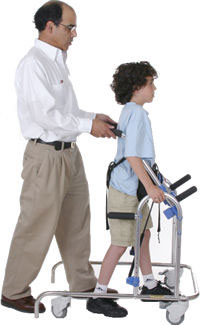Gait Development
The ultimate goal of many rehabilitation programs is to have the user walk. Maintaining or restoring the users lower extremity strength, building self-esteem and establishing increased independence are all-important benefits of walking.
All of the exercises described above were designed to develop the key building blocks of walking. Gait development is focused on integrating all of those elements.
The Up ‘n Go facilitates development of a normal gait in 4 critical ways:
- Support
- Trunk Control
- Dynamic Support throughout the gate cycle
- Facilitating the work of the therapist/caregiver

Support
The Up ‘n Go provides support that lifts a part of the user’s weight. This can be especially important in helping the user achieve a standing position, but continues to be important in carrying part of the user’s weight while they stand. By supplementing whatever strength the user has in their lower extremities, individuals who might otherwise be unable to stand can do so for often extended periods of time. As the user develops strength and technique, the level of support can be reduced.
In especially successful cases therapists have been able to take previously wheelchair bound patients and progress them through walking with ever decreasing support until they could walk on their own.
It is important to note that the lifting support provided by the Up ‘n Go is delivered directly to the trunk of the user’s body. There is no need for the user to support themselves with their hands as would be required using a conventional walker. This allows the upper body to be positioned with proper posture and helps to develop a normal gait.
Trunk Control
The Up ‘n Go stabilizes the user’s pelvis and helps align the user’s trunk over their legs. Because the Up ‘n Go supports the user above their center of gravity this alignment tends to occur ‘automatically’. In addition, the sense of stability and security this provides to the user allows them to focus on the task of walking without fear of falling. To further assist in achieving the proper body and leg positioning, accessories are available to assist patients who have issues with splaying or scissoring of one or both legs.
Dynamic Support
A critical capability of the Up ‘n Go provides is that the support it provides to the user remains constant as they shift position. This is referred to as true Partial Weight Bearing. In order to walk with a normal gait, we must slightly raise and lower our body and shift our weight from side to side. The Up ‘n Go allows the user to learn this weight shifting and timing while they are being supported by a constant level of support.
A good way to understand the dynamic support of the Up ‘n Go is to think of it as the land equivalent of Aquatic Therapy. The user has their body weight partially supported with constant support and without using their hands. A key difference with the Up ‘n Go is that in, addition to supporting the user, their pelvis is also stabilized. And, of course, getting the advantages of Aquatic Therapy without the complexities of working in water is a huge advantage for the therapist.
Facilitating the work of the Therapist
Coaching the complex mechanical and neurological interactions required in walking can be greatly facilitated when the therapist can focus their entire attention on that effort. Since the patient is supported and stabilized by the Up ‘n Go, there is no need for the therapist to lift or hold the patient. Thus the therapist can focus their effort on teaching. They become more of a coach and less of a participant in the process.
